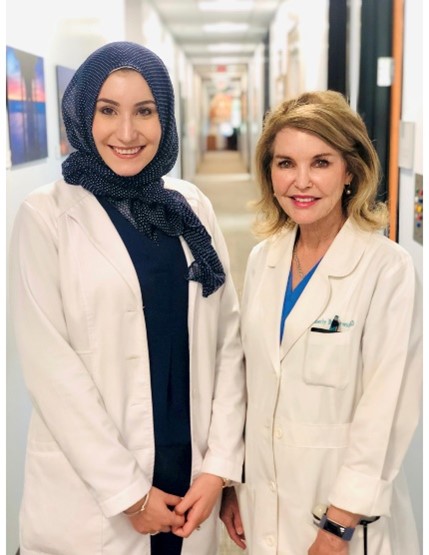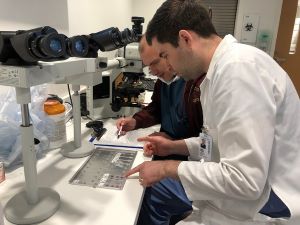
Preceptee Fatima Fahs, MD, with preceptor Kimberly Butterwick, MD.
“This opportunity provided me an inside look into Dr. Butterwick’s daily life as a cosmetic dermatologist. I observed cutting-edge procedures and the latest and greatest in cosmetic dermatology. I also witnessed why she has excellent patient rapport. One of our days started off bright and early in the office operating room as we gowned up and prepared for a liposuction and fat transfer case. Dr. Butterwick is a master of liposuction, and I learned so much watching her do this procedure! We wrapped up our case and bounced from room to room as I watched her skillfully administer neuromodulators and dermal fillers. Her artistic touch and ability to assess each individual patient to provide the best cosmetic outcome was amazing! I also spent time with Dr. Douglas Wu, who has mastered the treatment of facial hyperpigmentation with lasers, and Dr. Monica Boen, who shed light on her techniques administering dermal fillers with a cannula. I returned to Detroit with a repertoire of new skills to enhance my own patient care and results.”

Preceptee Daniel Knabel, MD, (far right) with preceptor Ian Maher, MD.
“A particular highlight of my time with Dr. Maher was learning about his approach to treating melanoma in situ of the face with micrographic surgery. Through my dermatology residency, I developed an interest in melanoma, particularly histology and immunohistochemistry. While rotating with Dr. Maher, I had the opportunity to observe a case of melanoma in situ of the eyelid treated with micrographic surgery. I was able to witness the staining process and interpretation of both H&E and Mart1 immunohistochemistry sections. With this technique, we were able to completely remove the patient’s melanoma while preserving important structures near the eye.”